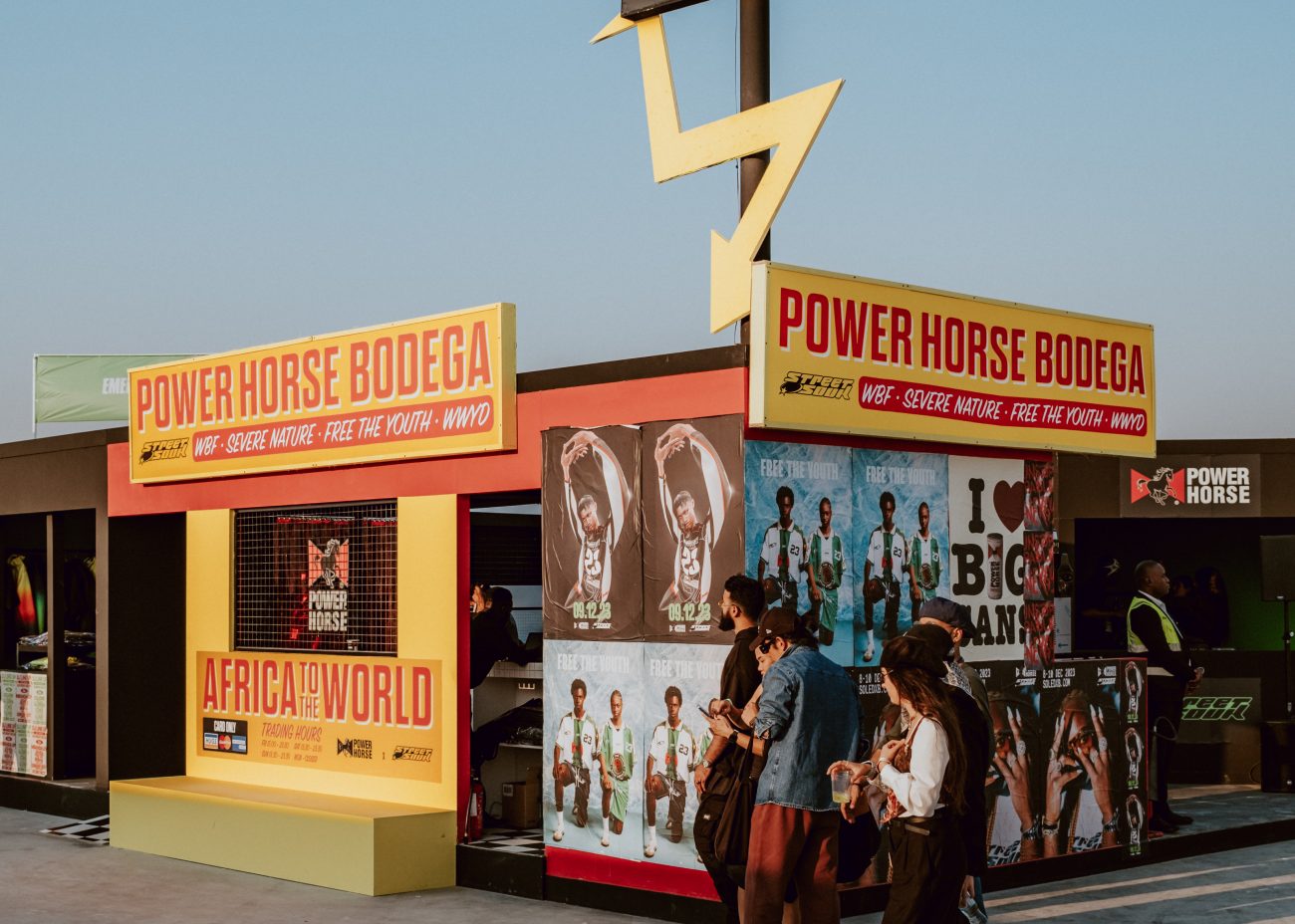Words Sophie Mayuko Arni
Photography K&L
An Insider’s Guide to Vintage Shopping In Tokyo
19.10.2023
Japan is pretty well known for its legendary brick-and-mortar designer vintage stores, but its secret style destination, beloved by locals, might just surprise you.

As a teenager, I already had my eye on a couple of designer pieces I saw in music videos and magazines. I remember my joy when finding a monogram Louis Vuitton Speedy 35; every teenage girl’s dream bag. I looked with shock at the price tag: $70. Yes, it was in used condition, but it still had many years to give. I wore that bag every single day for the rest of my subsequent high school years—even going into my freshman year of college—carrying it everywhere until the handles patinaed to the darkest shades of brown. Laptop, books, shoes, clothes, makeup. Everything seemed to fit in the weatherproof, circumstance-proof, Speedy 35.
I wish more teenagers could have the same experience at their local consignment shop and skip buying into the week’s latest fast-fashion trends on TikTok and Youtube. But I also understand my experience is unique. Most Speedys on the second-hand market go for at least five times more than what I paid at the time. But what makes Japan’s second-hand market unique? And what can we learn from the Japanese example when it comes to the growing supply and demand for vintage fashion?

As a starter, Japan is particularly well suited to trading valuable second-hand items. Three pillars have traditionally been credited for this: attention to detail, care for objects, and honesty in transactions. Selling a fake item would destroy years of hard work, and is frowned upon by the prevalent collectivist mindset. Add to this the incredible care Japanese people have for objects, and it’s no surprise that great marketplaces emerge. In the rare instance that a slight defect appears, Tokyo’s many vintage sellers will often document these with fastidious detail.
A fourth, and often overlooked pillar of the vintage market has been a large economy going through decades of stagnation. The ‘80s in Japan was a decade of bonus checks, frivolous spending, and incredible wealth accumulation. Furs, watches, designer bags, and even Impressionist paintings, were flooding into Japan’s borders. Sadly, the gilded era did not last; the ‘90s have often been called Japan’s “lost decade,” with an economic crisis that the country still hasn’t fully recovered from. Economic stagnation paired with an aging population has directly impacted the second-hand designer market. Consignment shops like the ones I frequented have become the repository of the shiny ‘80s, with items priced considerably lower than market value because younger generations see them as inherently outdated, being sold to them by an aging population.

Address B1F, Wako Bldg. 1-12-16 Jinnan,
Shibuya-ku,
Tokyo
$$$
Tucked away in a basement off Shibuya’s busy streets is Archive Store, dedicated to (yes, you guessed it…) archive pieces. Think Comme des Garçons’ Body Meets Dress, Dress Meets Body collection or Raf Simons’ Parachute bomber and pants. The rarest pieces are enclosed in glass cases, lest a wayward traveler decides to handle them with ungloved hands. Come here for an array of ready-to-wear garments.
As much as these stores offer an incredible selection, Japan’s best kept second-hand secret is not a brick-and-mortar boutique. Since the beginning of the pandemic, there has been a noticeable decrease in footfall across physical boutiques and a boom in peer-to-peer online marketplace traffic. Yahoo! Japan Auctions is a popular platform, well-regarded by stylists and expert vintage dealers worldwide, but better yet is an app called Mercari. Dubbed the “eBay of Japan,” Mercari is a peer-to-peer online marketplace, founded in 2013. With outposts in the US, it is considered one of Japan’s leading tech companies, with over JPY 10 billion (approximately $69.5 million as of printing of this article) in transactions fulfilled every month. It’s hands-down the number one shopping app in Japan, and has transcended the digital marketplace, being seen more as a lifestyle. Books, clothes, accessories, furniture, and even cars are traded across Mercari. I’ve even heard urban legends of food being traded on the app.
Mercari’s success goes back to the same codes of Japanese culture: buyers and sellers are required to follow a lengthy set of rules, both written and unwritten. Like on eBay, sellers have star-based ratings that influence and keep their customer transactions on track. But unlike eBay, Mercari’s shipping speed is unrivaled. Sellers will get tracked shipments, to their doorstep, within 2 to 5 days. It’s also incredibly convenient to use. Sellers write extensive and accurate product descriptions. Communication is lightning fast. Packages are packed to perfection, often including handwritten thank-you notes.

RAGTAG Harajuku
Address: 6-14-2 Jingumae,
Shibuya-ku,
Tokyo
$-$$$
RAGTAG boutiques are an institution for designer and vintage. With multiple branches across the country, RAGTAG is one of the largest aggregators of designer second-hand items. With their own system of categorizing wear and tear, from ‘as good as new’ to an A-to-D ranking for condition standards, and new stock everyday, RAGTAG offers pieces from a multitude of Japanese and Western brands, featuring young designers as well as the more established maisons. A must-go.
Mercari has become my vintage fashion school. From Fabio Rusconi to Elizabetta Franchi, I realized the value of the Made in Italy tagline. I’ve learned about materials, and the way they age after a decade. Scrutinizing nylon bags from both Prada and Yoshida & Co.’s Porter, I was able to conclude that they are of equal quality, despite a clear starting price difference, but oftentimes, Porter’s vintage nylon feels stronger, shinier, and more durable.
Another learning opportunity came with so-called “Old Céline” pieces (as a fan of Phoebe Philo, I was sad to see her leave her 2018 exit from the brand). A deep dive into Mercari’s Phoebe Philo Céline’s section allowed me to discover bags, shoes, sunglasses, jewelry, and clothing that I didn’t know she designed, like FW’12 block pointy heels and the Madame square toe boots.
The same goes for Issey Miyake. I discovered the universe of brands that he had launched during his lifetime.While Issey Miyake’s main brand and his famous Pleats Please line are known to many, not many are aware of his sports brand Hai Sporting Gear and his other foray into Plantation, an incredible brand of basics made of natural fabrics, with the most refined cotton I’ve ever experienced. Last year on Mercari, I found the heaviest, warmest, Plantation white turtleneck cotton sweater dating from the ‘80s for a whopping $50 (one of my proudest scores).
More recently, I have been on a self-imposed purchasing hiatus from your Zaras and H&Ms. A feat I’ve managed to achieve by scrolling on Mercari and digging through Tokyo’s vintage wares. Shopping pre-loved has made me more knowledgeable about supply chains, materials, and my environmental impact, and less susceptible to the magic of brand marketing. I’m aware that my position comes from privilege, and also my ease of access to beautiful vintage. But this goes to show that technology can work in wonderful ways, and peer-to-peer marketplaces might be the future wave of the fashion retail industry as a whole. Japan is not the only country to have adopted this new way of trading clothes, as the popularity of online vintage marketplaces such as Vestiaire Collective and Vinted is growing in France, and the rise of The RealReal in the US, or Depop can be particularly felt in the U.K. Perhaps the future of fashion retail is one that is less reliant on standardized global styles, shipped worldwide to look-alike shops in shopping malls, but rather adopts a more personal approach, based on localized online marketplaces and boutiques.

Address: Harajuku SH Bldg.
3-26-11 Jingumae,
Shibuya-ku,
Tokyo
$-$$
A can’t miss on Harajuku’s narrow back streets. Specializing in men’s vintage clothing, accessories, and flannels, the store may not seem obvious at first, but every item is carefully selected for its unique cut or fabric.
The same goes for Issey Miyake. I discovered the universe of brands that he had launched during his lifetime.While Issey Miyake’s main brand and his famous Pleats Please line are known to many, not many are aware of his sports brand Hai Sporting Gear and his other foray into Plantation, an incredible brand of basics made of natural fabrics, with the most refined cotton I’ve ever experienced. Last year on Mercari, I found the heaviest, warmest, Plantation white turtleneck cotton sweater dating from the ‘80s for a whopping $50 (one of my proudest scores).

Address: Omotesando Bldg. 3F Lawson. 4 Chome−29−3 Jingumae, Shibuya-ku,
Tokyo
$-$$$
Kindal is similar to RAGTAG. It’s a large reseller with multiple store branches found across the country. Their Harajuku location is a must-see for the sheer volume of product they carry for men and women. You’re unlikely to leave without finding a gem. You’ll find them on the third floor of a building on the main Omotesando avenue.
More recently, I have been on a self-imposed purchasing hiatus from your Zaras and H&Ms. A feat I’ve managed to achieve by scrolling on Mercari and digging through Tokyo’s vintage wares. Shopping pre-loved has made me more knowledgeable about supply chains, materials, and my environmental impact, and less susceptible to the magic of brand marketing. I’m aware that my position comes from privilege, and also my ease of access to beautiful vintage. But this goes to show that technology can work in wonderful ways, and peer-to-peer marketplaces might be the future wave of the fashion retail industry as a whole. Japan is not the only country to have adopted this new way of trading clothes, as the popularity of online vintage marketplaces such as Vestiaire Collective and Vinted is growing in France, and the rise of The RealReal in the US, or Depop can be particularly felt in the U.K. Perhaps the future of fashion retail is one that is less reliant on standardized global styles, shipped worldwide to look-alike shops in shopping malls, but rather adopts a more personal approach, based on localized online marketplaces and boutiques.
Read more

It takes a village and a year to put our show together and then it's over in the blink of an eye. Seeing what we captured filled us with gratitude for the people that this festival has brought into our lives.

A Sole x Afika Conversation with ODDISEE

The sportswear giant followed their principal of Sound Mind, Sound Body, building a respite from the hustle and bustle of the festival. The space carried echoes of Japanese design and featured a chess tournament with Lupe Fiasco.

Power Horse partnered with Street Souk to bring the very best of the West African fashion community to our 2023 edition of Sole DXB. Showcasing six designers in a purpose-built multibrand space.
